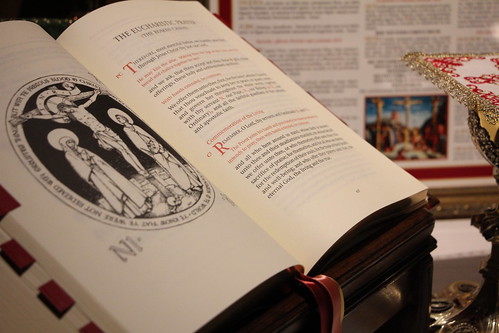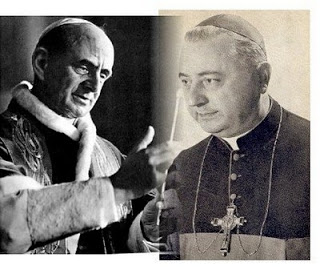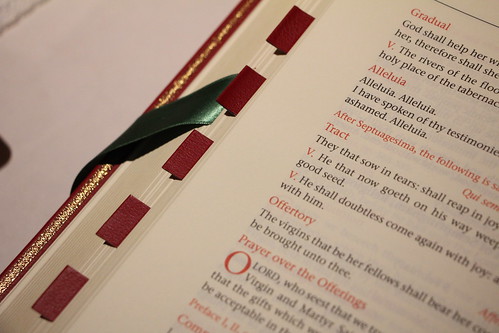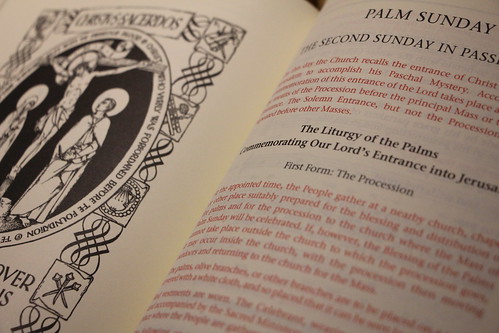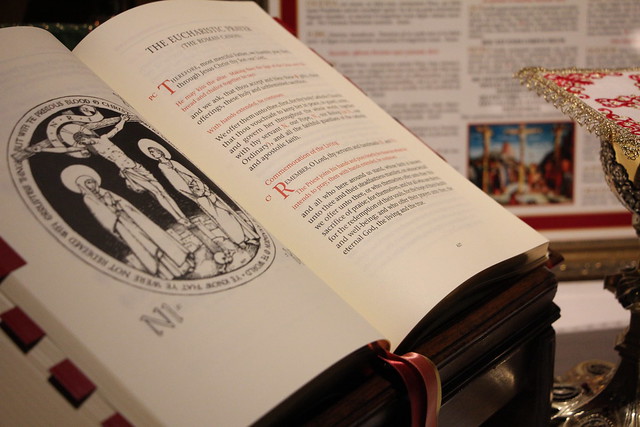It would be quite easy to transform the current Ordinary Form Mass and make it more in continuity with the Extraordinary Form Mass, although with an English version faithful to the Latin text of the Ordinary Form.
I would like to see what "Divine Worship: The Missal" has for each Sunday, the traditional Introit with the gradual/alleluia or tract printed on the page as well as the Offertory and Communion antiphons. I would also like the Anglican Ordinariate's calendar with all the restored things the have from our Extraordinary Form.
But apart from that, the following could be implemented overnight with a mere appendix:
The Asperges (Vidi Aquuam, during Easter) restored prior to Mass with priest wearing cope--optional.
PRAYERS AT THE FOOT OF THE ALTAR
[At a High Mass, the Processional Hymn and Introit are sung by choir/congregation as the priest and ministers pray at the foot of the altar and through the incensation of the altar. In a Low Mass, the congregation make also take the parts of the server in the PATFOTA and then the priest after ascending the altar to kiss it, reads the Introit alone or together with the congregation.)
[Bowing before the altar, the priest makes the sign of the cross, saying:
P: In the name of the Father, (+) and of the Son, and of the Holy Spirit. Amen.
P: I will go in to the altar of God.
R: To God, Who gives joy to my youth.
PSALM 42
[The priest and server say alternately:]
P: Judge me, O God, and distinguish my cause from the nation that is not holy; deliver me from the unjust and deceitful man.
R: For Thou art, God, my strength; why hast Thou cast me off? and why do I go all sorrowful whilst the enemy afflict me?
P: Send forth Thy light and Thy truth: they conducted me and brought me unto Thy holy hill, and into Thy tabernacles.
R: And I will go in to the altar of God: to God Who gives joy to my youth.
P: To Thee, O God, my God, I will give praise upon the harp: why art thou sad, O my soul, and why dost thou disquiet me?
R: Hope in God, for I will still give praise to Him, the salvation of my countenance and my God.
P: Glory be to the Father, and to the Son, and to the Holy Spirit.
R: As it was in the beginning, is now, and ever shall be, world without end. Amen.
P: I will go in to the altar of God.
R: To God, Who gives joy to my youth.
P: Our help (+) is in the name of the Lord.
R: Who made heaven and earth.
[Bowing down low, the priest says:]
P: I confess to almighty God, to blessed Mary ever virgin, to blessed
Michael the archangel, to blessed John the Baptist, to the holy
apostles Peter and Paul, to all the saints, and to you, brethren, that I
have sinned exceedingly in thought, word and deed: (The priest strikes
his breast three times saying:) through my fault, through my fault,
through my most grievous fault. Therefore I beseech the blessed Mary
ever virgin, blessed Michael the archangel, blessed John the Baptist,
the holy apostles Peter and Paul, all the saints, and you, brethren, to
pray to the Lord our God for me.
R: May almighty God have mercy on thee and, having forgiven thee thy sins, bring thee to life everlasting.
P: Amen.
[The server now says:]
R: I confess to almighty God, to blessed Mary ever virgin, to
blessed Michael the archangel, to blessed John the Baptist, to the holy
apostles Peter and Paul, to all the saints, and to thee, Father, that I
have sinned exceedingly in thought, word, and deed: (The acolyte strikes
his breast three times saying:) through my fault, through my fault,
through my most grievous fault. Therefore I beseech the blessed Mary
ever virgin, blessed Michael the archangel, blessed John the Baptist,
the holy apostles Peter and Paul, all the saints, and thee, Father, to
pray to the Lord our God for me.P: May almighty God have mercy on you and, having forgiven you your sins, bring you to life everlasting.
R: Amen.
[The priest signs himself, saying:]
P: May the almighty and merciful Lord grant us pardon, (+) absolution, and remission of our sins.
R: Amen.
[Again bowing slightly, the priest goes on:]
P: Thou wilt turn again, O God, and quicken us.
R: And Thy people will rejoice in Thee.
P: Show us, O Lord, Thy mercy.
R: And grant us Thy salvation.
P: O Lord, hear my prayer.
R: And let my cry come unto Thee.
P: The Lord be with you.
R: And with thy Spirit.
P: Let us pray.
[Going up to the altar, the priest prays silently:]
P: Take away from us our iniquities, we beseech Thee, O Lord;
that, being made pure in heart we may be worthy to enter into the Holy
of Holies. Through Christ our Lord. Amen.
[He bows down over the altar, which he kisses, saying:]
P: We beseech Thee, O Lord, by the merits of those of Thy saints
whose relics are here, and of all the saints, that Thou wouldst
vouchsafe to pardon me all my sins. Amen.
[If incense is used, the priest recites the proper psalm quietly to himself]
(The priest does not recite the Introit if the choir/congregation have chanted it)
KYRIE ELEISON
[The priest returns to the middle of the altar and says alternately with the server:]
P: Lord, have mercy.
R: Lord, have mercy on.
P: Lord, have mercy on.
R: Christ, have mercy.
P: Christ, have mercy.
R: Christ, have mercy.
P: Lord, have mercy.
R: Lord, have mercy.
P: Lord, have mercy.
GLORIA IN EXCELSIS
[Now follows the Gloria, when it is prescribed. Standing
at the middle of the altar, the priest extends and joins his hands, and
making a slight bow says:]
Glory to God...
[Turning to the people, the priest says:]
P: The Lord be with you.
R: And with your Spirit.
THE PRAYER / COLLECT
[Here the priest says the collect appointed for the day.]
P: Let us pray.
THE LITURGY OF THE WORD
[The Liturgy of the Word continues using the three year post-Vatican II lectionary, with lay readers as is currently the norm. However, the gradual/tract and any sequence to include the Dies Irae for a Requiem Mass are options clearly printed in the missal.]
GOSPEL:
[The priest, returning to the middle of the altar, bows down, joins his hands, and says:]
P: Cleanse my heart and my lips, O almighty God, Who didst cleanse
with a burning coal the lips of the prophet Isaias; and vouchsafe in Thy
loving kindness so to purify me that I may be enabled worthily to
announce Thy holy Gospel. Through Christ our Lord. Amen.
Vouchsafe, O Lord, to bless me. The Lord be in my heart and on my
lips, that I may worthily and becomingly announce His gospel. Amen.
[The priest goes to the ambo and reads the Gospel for the Mass he is celebrating.]
[If the Deacon proclaims the Gospel, he asks for the priest's blessing.
Priest: Vouchsafe, O Lord, to bless you that the Lord be in your heart and on your lips to worthily and becomingly announce His Gospel, in the name of the Father....
THE LITURGY OF THE EUCHARIST
Credo (at center of altar with genuflection at Incarnate...)
Universal Prayer (at center of altar)
(Collection and Presentation of the Offerings as the altar is prepared)
THE OFFERTORY
[The priest now says the Offertory for the Mass being offered in a lower voice says:]
The Offering of the Host
P: Receive, O Holy Father, almighty and eternal God,
this spotless host, which I, Thine unworthy servant, offer unto Thee, my
living and true God, for my countless sins, trespasses, and omissions;
likewise for all here present, and for all faithful Christians, whether
living or dead, that it may avail both me and them to salvation, unto
life everlasting. Amen.
[The priest goes to the Epistle side (or deacon) and pours wine and water into the chalice.]
P/D: O God, Who in creating man didst exalt his nature very wonderfully
and yet more wonderfully didst establish it anew: by the mystery
signified in the mingling of this water and wine, grant us to have part
in the Godhead of Him Who hath vouchsafed to share our manhood, Jesus
Christ, Thy Son, Our Lord, Who lives and reigns with You in the
unity of the Holy Spirit, God; world without end. Amen.
The Offering of the Chalice
[At the middle of the altar, the priest says:]P: We offer unto Thee, O Lord, the chalice of salvation, beseeching Thy
clemency that it may ascend as a sweet odor before Thy divine majesty,
for our own salvation, and for that of the whole world. Amen.
P: Humbled in mind, and contrite of heart, may we find favor with Thee, O
Lord; and may the sacrifice we this day offer up be well pleasing to
Thee, Who art our Lord and our God.
P: Come, Thou, the Sanctifier, God, almighty and everlasting: bless
(+) this sacrifice which is prepared for the glory of Thy holy name.
The Lavabo
[Going to the Epistle side, the priest washes his hands and says:]P: I will wash my hands among the innocent, and will cleanse compass
Thine altar, O Lord. That I may hear the voice of praise, and tell of
all Thy wondrous works. I have loved, O Lord, the beauty of Thy house,
and the place where Thy glory dwelleth. Take not away my soul, O God,
with the wicked; nor my life with men of blood. In whose hands are
iniquities: their right hand is filled with gifts. But as for me, I have
walked in my innocence; redeem me, and have mercy on me. My foot hath
stood in the right way; in the churches I will bless Thee, O Lord. Glory
be to the Father, and to the Son, and to the Holy Spirit. As it was in
the beginning, is now, and ever shall be; world without end. Amen.
[The priest returns to the middle of the altar and bowing slightly, says:]
P: Receive, O holy Trinity, this oblation offered up by us to
Thee in memory of the passion, resurrection, and ascension of Our Lord
Jesus Christ, and in honor of blessed Mary, ever a virgin, of blessed
John the Baptist, of the holy apostles Peter and Paul, of these, and of
all the saints, that it may be available to their honor and to our
salvation; and may they whose memory we celebrate on earth vouchsafe to
intercede for us in heaven. Through the same Christ our Lord. Amen.
The Orate Fratres
[The priest kisses the altar and turning to the people, says:]
P: Brethren, pray that my sacrifice and yours may be well pleasing to God the Father almighty. |
| R: May the Lord receive this sacrifice at... | | |
THE PRAYER OVER THE OFFERINGS
[Then with hands extended, the priest says the Prayer over the Offering.]
The Preface
The Sanctus
The Roman Canon
[The priest now prays in an audible voice facing the altar.]
P: Therefore, we humbly pray and beseech Thee, most merciful Father,
through Jesus Christ Thy Son, Our Lord, to receive and to bless these
(+) gifts, these (+) presents, these (+) holy unspotted sacrifices,
which we offer up to Thee, in the first place, for Thy holy Catholic
Church, that it may please Thee to grant her peace, to guard, unite, and
guide her, throughout the world: as also for Thy servant N., our Pope,
and N., our Bishop, and for all who are orthodox in belief and who
profess the Catholic and apostolic faith.
The Commemoration of the Living
P: Be mindful, O Lord, of Thy servants, N. and N., and
of all here present, whose faith and devotion are known to Thee, for
whom we offer, or who offer up to Thee, this sacrifice of praise, for
themselves, their families, and their friends, for the salvation of
their souls and the health and welfare they hope for, and who now pay
their vows to Thee, God eternal, living, and true.
The Communicantes
P: Having communion with and venerating the memory,
first, of the glorious Mary, ever a virgin, mother of Jesus Christ, our
God and our Lord: likewise {of blessed Joseph, spouse of the same
virgin} of Thy blessed apostles and martyrs, Peter and Paul, Andrew,
James, John, Thomas, James, Phillip, Bartholomew, Matthew, Simon and
Thaddeus; of Linus, Cletus, Clement, Sixtus, Cornelius, Cyprian,
Lawrence, Chrysogonus, John and Paul, Cosmas and Damian, and of all Thy
saints: for the sake of whose merits and prayers do Thou grant that in
all things we may be defended by the help of Thy protection. Through the
same Christ, our Lord. Amen.
The "Hanc Igitur"
[The priest extends his hands over the oblation]
|
| P: Wherefore, we beseech hands over the oblation. Thee, O
Lord, graciously to receive this oblation which we Thy servants, and
with us Thy whole family, offer up to Thee: dispose our days in Thy
peace; command that we be saved from eternal damnation and numbered
among the flock of Thine elect. Through Christ our Lord. Amen.
[Here the bell is rung once.] |
Quam Oblationem
P: And do Thou, O God, vouchsafe in all respects to
bless (+), consecrate (+), and approve (+) this our oblation, to perfect
it and render it well-pleasing to Thyself, so that it may become for us
the body (+) and blood (+) of Thy most beloved Son, Jesus Christ our
Lord.
The Consecration of the Host
P: Who, the day before He suffered, took bread into His
holy and venerable hands, and having lifted up His eyes to heaven, to
Thee, God, His almighty Father, giving thanks to Thee, blessed it (+),
broke it, and gave it to His disciples, saying:
Take ye and eat ye all of this:
[The priest bends over the Host and says:]
FOR THIS IS MY BODY.
[Then the priest adores, genuflects then elevates the Sacred Host. The bell is rung, genuflects again.]
The Consecration of the Wine
[The priest uncovers the Chalice and says:]P: In like manner, after He had supped, taking also into His holy and
venerable hands this goodly chalice again giving thanks to Thee, He
blessed it (+), and gave it to His disciples, saying:
Take ye, and drink ye all of this:
[The priest bends over the Chalice and says:] FOR THIS IS THE CHALICE OF MY BLOOD, OF THE NEW AND EVERLASTING
TESTAMENT WHICH FOR YOU AND FOR MANY SHALL BE
SHED UNTO THE REMISSION OF SINS.
P: As often as ye shall do these things, ye shall do them in memory of Me.
[The priest adores, genuflects then elevates the Chalice. The bell is rung. He genuflects again then continues:]
THE MYSTERY OF FAITH
(one of the three acclamations are chanted or said)
P: Wherefore, O Lord, we, Thy servants, as also Thy holy people, calling
to mind the blessed passion of the same Christ, Thy Son, our Lord, His
resurrection from the grave, and His glorious ascension into heaven,
offer up to Thy most excellent majesty of Thine own gifts bestowed upon
us, a victim (+) which is pure, a victim (+) which is stainless, the
holy bread (+) of life everlasting, and the chalice (+) of eternal
salvation.
P: Vouchsafe to look upon them with a gracious and tranquil countenance,
and to accept them, even as Thou wast pleased to accept the offerings
of Thy just servant Abel, and the sacrifice of Abraham, our patriarch,
and that which Melchisedech, Thy high priest, offered up to Thee, a holy
sacrifice, a victim without blemish.
P: We humbly beseech Thee, almighty God, to command that these our
offerings be borne by the hands of Thy holy angel to Thine altar on high
in the presence of Thy divine Majesty; that as many of us as shall
receive the most sacred (+) Body and (+) Blood of Thy Son by partaking
thereof from this altar may be filled with every heavenly blessing and
grace: Through the same Christ our Lord. Amen.
The Commemoration of the Dead
P: Be mindful, also, O Lord, of Thy servants N. and N.,
who have gone before us with the sign of faith and who sleep the sleep
of peace.
P: To these, O Lord, and to all who rest in Christ, grant, we beseech
Thee, a place of refreshment, light, and peace. Through the same Christ
our Lord. Amen.
[Striking his breast, the priest says:]
P: To us sinners, also, Thy servants, who put our trust in the
multitude of Thy mercies, vouchsafe to grant some part and fellowship
with Thy holy apostles and martyrs; with John, Stephen, Matthias,
Barnabas, Ignatius, Alexander, Marcellinus, Peter, Felicitas, Perpetua,
Agatha, Lucy, Agnes, Cecilia, Anastasia, and with all Thy saints. Into
their company do Thou, we beseech Thee, admit us, not weighing our
merits, but freely pardoning our offenses: through Christ our Lord.
[Raising Chalice and Paten]
P: By Whom, O Lord, Thou dost always create, sanctify (+), quicken (+), bless (+), and bestow upon us all these good things.P: Through Him (+), and with Him (+), and in Him (+), is to Thee, God
the Father (+) almighty, in the unity of the Holy (+) Spirit, all honor
and glory. World without end.
R/Amen.
THE RITE OF HOLY COMMUNION
[The Pater Noster with its embolism and doxology is prayed as it is in the Ordinary Form to include also the Communion Rite of priest and congregation.]
|
|
|
THE COMMUNION VERSE (AND IN SUNG MASSES ANY OTHER MOTETS OR CONGREGATIONAL HYMNS.)
[The priest at the Epistle side recites the Communion for the Mass being celebrated unless it has been chanted.]
P: The Lord be with you.
R: And with thy Spirit.
THE POSTCOMMUNION PRAYER
P: Let us pray.
[The priest at the Epistle side recites the Post Communion for the Mass being celebrated.]
R: Amen.
THE BLESSING AND DISMISSAL
[Then he returns to the middle, kisses the altar, and turning toward the people says:]
P: The Lord be with you.
R: And with thy Spirit.
P: May almighty God, the Father, and the Son (+), and the Holy Ghost, bless you.
R: Amen.
[Bowing down over the altar, the priest says:]
P: May the lowly homage of my service be pleasing to Thee, O most
holy Trinity: and do Thou grant that the sacrifice which I, all
unworthy, have offered up in the sight of Thy majesty, may be acceptable
to Thee, and, because of Thy loving kindness, may avail to atone to
Thee for myself and for all those for whom I have offered it up. Through
Christ our Lord. Amen.
[The priest or deacon turns toward the congregation and says or chants]
P: Go, the Mass is ended.
R: Thanks be to God.
THE LAST GOSPEL (OPTIONAL)
THE RECESSIONAL | | | | | | | | | | | | | | | | | | | | | | | | | | | | | | | | | | | | | | | | | | | | | | | | | | | | | | | | | | | | | | | | | | | |
| | | |







